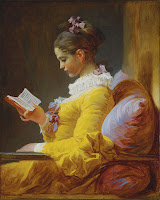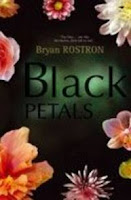 As we review our favourite self-help books, we are not taking a survey of those glitzy volumes that crowd the so-called psychology sections of bookshops, with their trite philosophies and shallow epigrams, their pseudo-science and convoluted logic. Our self-help books are a selection of volumes, both fiction and non-fiction, that have taught us how to live. They are, in no particular order and without exhausting the list:
As we review our favourite self-help books, we are not taking a survey of those glitzy volumes that crowd the so-called psychology sections of bookshops, with their trite philosophies and shallow epigrams, their pseudo-science and convoluted logic. Our self-help books are a selection of volumes, both fiction and non-fiction, that have taught us how to live. They are, in no particular order and without exhausting the list:Jean-Honoré Frangonard, The Reader (Lesende Frau), oil on canvas. National Gallery of Art, Washington, D.C.
1. The Catcher in the Rye by J.D. Salinger. This is the coming-of-age story that defined all others. Holden Caulfield taught us in equal doses how to live and how not to live.
2. The Hero with a Thousand Faces by Joseph Campbell. Written by the sociologist as a guide to myth, it tells us plenty about the human condition.
3. the poems of Emily Dickinson. Simple and pretty, these verse whittle life away to its fundamentals.
4. Passage to India by E.M. Forster – and all the works of the Moderns for that matter. Plagued by a vague sense of existential unease, the Moderns resisted throwing out the baby with the bath water as we Post-moderns have done. The result is subtly chilling, and inspiring.
5. the works of Friedrich Nietzsche. Using logic, the philosopher pulled apart the foundations of our world so that we could build it up from scratch again.
6. The Diary of Anne Frank. Anne Frank, in her quiet way, teaches us courage and gratitude. All the tears shed on her behalf, by people of different races, religions and nationalities, testify to the need for tolerance and understanding. We are more alike than we are different, when it comes down to it, and it took this book, translated into almost every language imaginable, to show us that.
7. The Paper House by Carlos Maria Dominguez. Although we’ve already explained why we chose to name this blog after the petite illustrated work, the quote below should seal the deal. Any true bibliophile will see themselves reflected between its pages.
8. the agreements and disagreements of Freud and Jung. Take an excerpt from The Four Archetypes, tack it to a page from Interpreting Dreams, stir it in with A Case of Hysteria and a dose of Modern Man in Search of a Soul, and you may not come out any wiser but you will certainly be more aware of the intricacies and contradictions of the human mind.
9. your high school history textbook. To appropriate a well-worn idea, you cannot know who you are without knowing where you come from.
10. and, of course, the oeuvre of Shakespeare. As many before us have pointed out, the Bard reveals a wealth about human nature and our emotions, whether through a comedy, tragedy or historical play. We could not possibly pick one as our favourite.
"I have often asked myself why I keep books that could only ever be of any use in a distant future, titles remote from my usual concerns, those that I have read once and will not open again for many years, if ever! But how could I throw away The Call of the Wind, for example, without destroying one of the building blocks of my childhood, or Zorba the Greek, which brought my adolescence to a tear-stained end... We prefer to lose a ring, a watch, our umbrella, rather than a book whose pages we will never read again, but which retains, just in the sound of its title, a remote and perhaps long-lost emotion." (The Paper House, p.12–3)





 It seems that the blurb of each new book published locally, whether fiction or non-fiction, claims to represent the state of South Africa today in stark, unprecedented honesty. And more often than not it is a country depicted either as shackled to its past or with the key to its manacles in its bloodied fingers. Black Petals by Bryan Rostron is another such novel, one which understands the past as a tangle of secrets that only recede further as one approaches, and the present as just as illusory.
It seems that the blurb of each new book published locally, whether fiction or non-fiction, claims to represent the state of South Africa today in stark, unprecedented honesty. And more often than not it is a country depicted either as shackled to its past or with the key to its manacles in its bloodied fingers. Black Petals by Bryan Rostron is another such novel, one which understands the past as a tangle of secrets that only recede further as one approaches, and the present as just as illusory.






